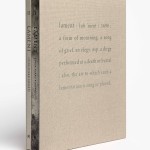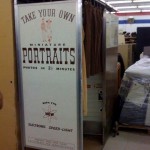Rachael Banks: The States Project: Kentucky
I have been aware of Rachael Banks’ photography for the past couple years while touring around the state. Both being active members of photography educators conferences in the region, I’ve seen her and her work a dozen times, yet we’ve never met until I reached out to her for this article. I have always been interested in the personal relationships she has with her subjects. I enjoy long term documentary projects and hers above mosts, but It wasn’t until we spoke that I learned how photographing her family for this series drew her back to Kentucky.
 Rachael Banks (b. Louisville, KY) is an Assistant Professor of Photography at Northern Kentucky University and is based in Newport, KY. She received an MFA in photography from Texas Woman’s University (Denton, TX).
Rachael Banks (b. Louisville, KY) is an Assistant Professor of Photography at Northern Kentucky University and is based in Newport, KY. She received an MFA in photography from Texas Woman’s University (Denton, TX).
Rachael’s work focuses primarily on family dynamics and personal experience. She is especially interested in social subcultures and identity informed by place. Specifically, Rachael’s creative research focuses largely on her identity and community found within the state of Kentucky and the Midwest/southern region. Her creative work is distinctly influenced by socio-economic issues that are present in her home state and how it affects her familial relationships.
Rachael is an avid supporter of self-publishing, zines, and education (in all forms). Her work has been shown regionally, nationally, and internationally.
Between Home and Here
Some of us have made terrible mistakes. I have always been drawn to using photography as a tool to document the aftermath of trauma and how that shapes one’s identity.
Being a photographer has taught me to re-examine what has always been in front of me. Being from Kentucky has taught me to appreciate that in all things that are flawed there is also great promise. I am from a place that gives back what you put into it.
To an outsider, Kentucky may not seem like a place with much to offer. It’s easy to look at all of the things it isn’t instead of what it can be. In photographing my family, I see that they share many of the same sentiments about themselves and it parallels with this place. I know sometimes I see that in myself. But I’ve never been interested in just the surface of things.
I am the oldest of three, but more like a mother than a sister. I constructed a family of siblings, both real and assumed. Between Home and Here is an ongoing photographic project that addresses deeply internalized guilt and the essence of loved ones.
This is a story about hating and loving where you are from. It comes from doing anything to go back to a place that you left.
I left my heart in Kentucky and came back to find it. The photographs are artifacts from my search.- Rachael Banks
James Robert Southard: Growing up in kentucky, when and where was your first exposure to photography.
Rachael Banks: I started shooting with my first camera (Pentax k1000) when I was 13 years old and living in the suburbs of Louisville, KY. I have a mixed family so I am the oldest of 7 and I spent a lot of my adolescence babysitting my younger siblings. Growing up, my mom was the unofficial family archivist and documented everything with her camera. At a very early age, I developed an understanding of the camera as a tool with the ability to preserve time. My mom doesn’t consider herself a photographer/artist but I have to credit her with passing along the impulse to document everything. I was also very fortunate to go to a high school with a darkroom and a very enthusiastic photographer instructor who encouraged me to utilize photography as a means for self-expression and providing insight into my life.
Your work looks incredibly personal. Is this series your first time using family as a subject or is this something you are familiar with? What influenced your choice of photographing family in the first place.
I find value in making work that is honest and a reflection of what I know. Family life isn’t the most obscure subject in photography but it is important to me and a large part of my identity. I’ve always been driven to make work that is introspective and exploring where I find my place in the world. When I first started taking photography seriously, all of my work was based around self-portraiture because I felt that the only way to make work about myself was to photograph myself. I got burned out making self-portraits and on a whim I decided to photograph my brother just to have something to do – that was six years ago and I haven’t looked back since that day. Through making work about others and my relationships with them, I am still examining issues about myself (maybe more so than I ever was through self-portraiture) but it is presented in a different way. My work is definitely very personal because I am mostly only making images with people I am close to. The willingness of my close friends and family to lend their likenesses to my photographic research is something I don’t take lightly. As my life and family transitions through time, my work does too, so there is always something for me to make photographs about.
I agree with you that these family portraits are an extension of your own self portraits. And I have always felt the creating long term self portrait series is an act of surveying one’s’ own evolution. While you have been shooting these images, what has changed. Not just physically, but more than that.
When I first started producing my family work, I was a graduate student and living in Dallas, TX. There was a very heightened sense of urgency and pressure to make as much work as frequently as possible because of the limitations set by distance and availability. I spent two years driving back and forth to Louisville, KY on a monthly basis (sometimes I would visit 2-3 times a month). Since relocating back to Kentucky, I still have a strong drive to make work but I have the ability to plan, think, and re-shoot with more ease. I’ve also discovered that while I don’t currently produce as much at one time, I have the opportunity to spend more time thinking about my shooting approach and being more intentional in the photographs that I take, which has been very valuable to me. Additionally, because I am working with people and people that I am close to, as time has passed and the project has grown, I’ve taken a step back to focus more on the relationships I foster with others and not so much the end product (the photograph). I want to be considerate and not lose sight of the people I photograph as being people who I love and not just photographic subjects for my research.
When studying photography, what and who were your influences? You have a strong body of portrait work and I am curious what got you to where you are.
As an undergraduate student, I was heavily influenced by my mentors Laura Hartford and Sarah Lyon. During the entirety of my photographic career, I’ve had really great mentors who I respected as educators and artists. I remember the first time I saw a Francesca Woodman portrait in my photo 1 class and having a lightbulb moment where I definitively knew I wanted to be a photographer. Some of the most important photographers who helped influence the way I look at constructing images have been Emmet Gowin, Larry Sultan, Susan Virginia Worsham, Latoya Ruby Frazier, Elinor Carucci, Tierney Gearon, Edward Weston, and Nan Goldin. I’m also heavily influenced by painting, everything in the punk/DIY scene, botany, and poetry. As a photographer, I think it is important to look beyond photography to see what else can/does influence my work and how we are all connected through creative expression (and some science)
Please take me through one of your perfect days of shooting or in the studio.
A perfect day of shooting is rarely on a day where I actively plan to shoot. I get the most excited on the days where I travel to spend time with family/friends and something completely unplanned will happen or I’ll find myself mid-conversation as the clouds suddenly shift and there is perfect light. I am the person who will be at a family function and in the middle of an event I am suddenly running to my car to grab my camera because in a perfect encounter with chance, a photograph that needs to be made has presented itself to me. The perfect shooting day is never a planned one and it’s an appropriate reminder to myself that some of the best things find me when I’m not looking for them.
Posts on Lenscratch may not be reproduced without the permission of the Lenscratch staff and the photographer.
Recommended
-
The Next Generation and the Future of PhotographyDecember 31st, 2025
-
Aaron Rothman: The SierraDecember 18th, 2025
-
Photographers on Photographers: Congyu Liu in Conversation with Vân-Nhi NguyễnDecember 8th, 2025
-
Linda Foard Roberts: LamentNovember 25th, 2025
-
Arnold Newman Prize: C. Rose Smith: Scenes of Self: Redressing PatriarchyNovember 24th, 2025









































































